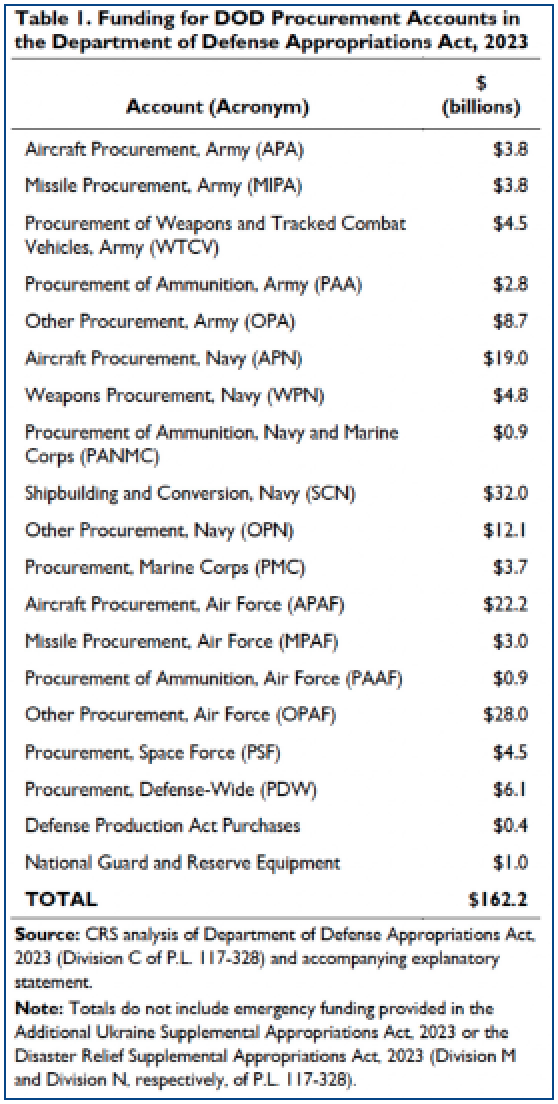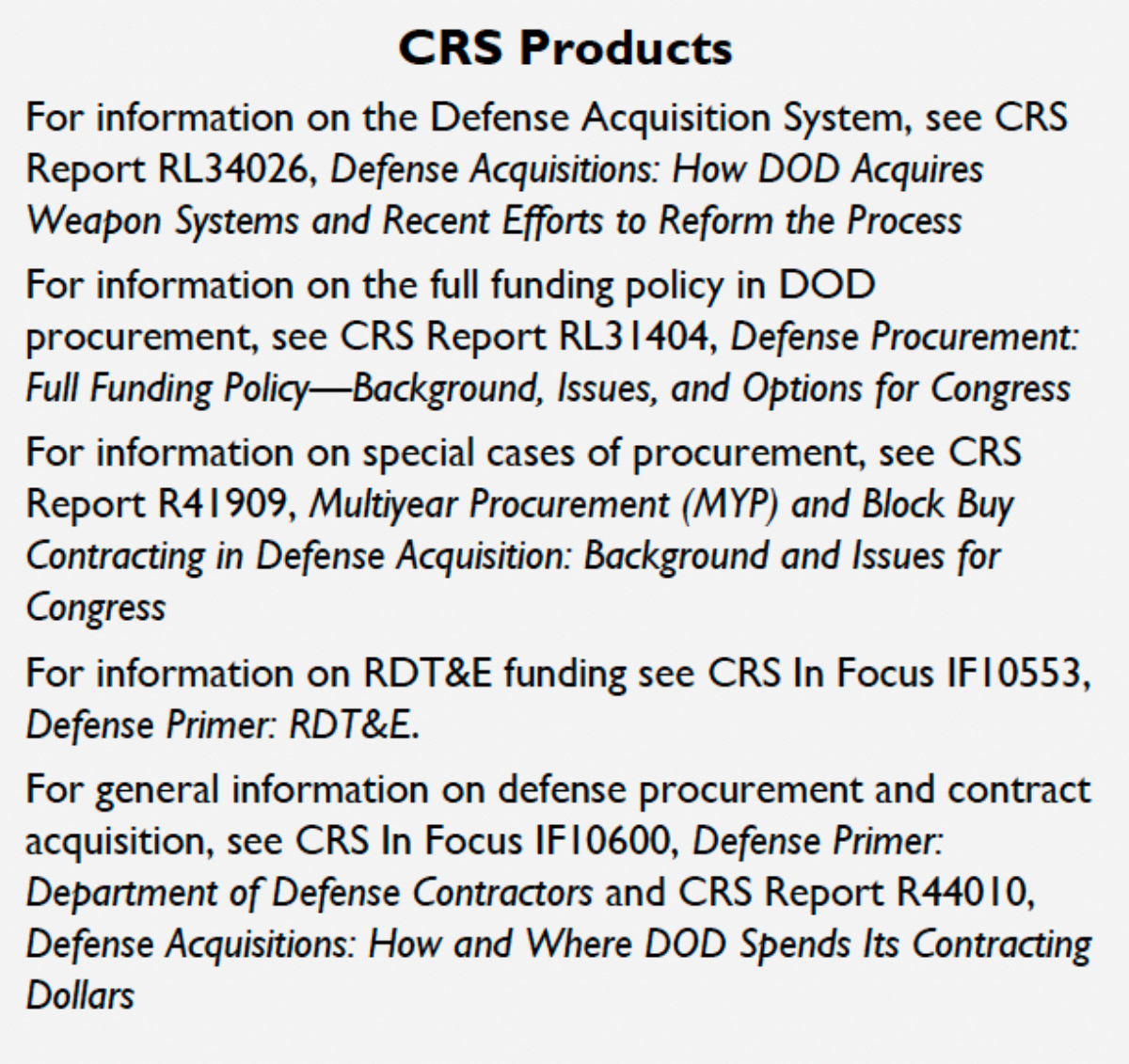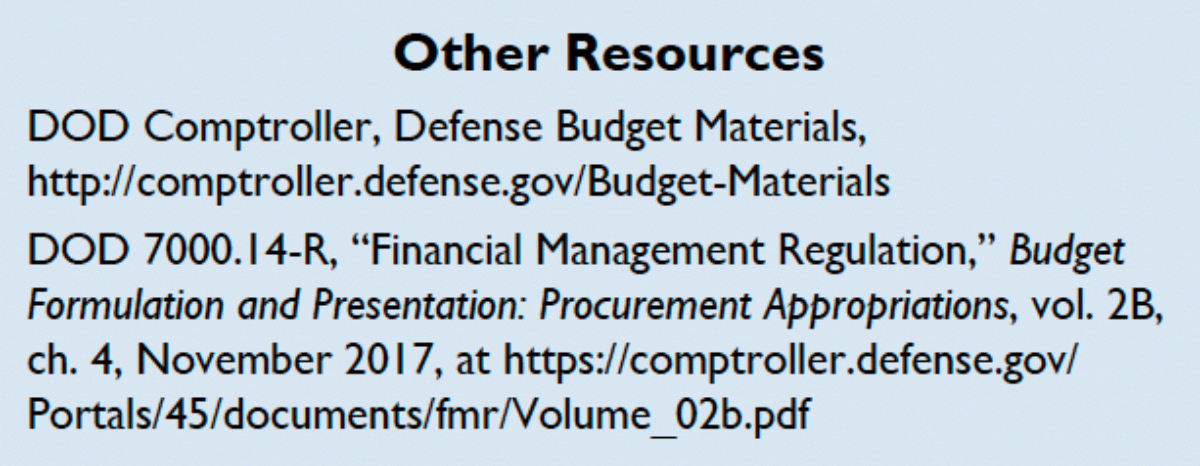Background

While procurement implies a process of obtaining goods or services, the word also refers to a specific title and associated accounts within the annual National Defense Authorization Act (NDAA) and Department of Defense Appropriations Act.
Appropriations for Procurement
The Department of Defense (DoD) procurement appropriations title provides funds for non-construction-related investment costs — the costs to acquire capital assets, such as an F-35 Joint Strike Fighter aircraft or a Virginia-class submarine. Investment costs are distinguished from expenses—the costs of resources consumed in operating the department, such as food and fuel. DoD uses procurement appropriations to obtain various categories of materiel, including...
• New military hardware (e.g., satellites, aircraft, ships, armored vehicles, and radios);
• Upgrades to existing equipment, including service life extension or re-manufacturing programs;
• Weapons and ammunition (e.g., air-to-air missiles and rifle rounds)
• Spares and repair parts

Procurement funding provided to the department in a given fiscal year can usually be obligated over a period of three years. The most prominent exception is Navy Shipbuilding and Conversion funding, which is available for five years. The Department of Defense Appropriations Act, 2023 (Division C of P.L. 117-328) provided $162.2 billion for procurement accounts (see Table 1).
How is DoD Procurement Funded?
In general, Congress appropriates money for defense procurement under a policy of full funding, which requires funding the entire procurement cost of end-items (e.g., AIM-9 Sidewinder missiles or KC-46A refueling tankers) in one fiscal year.

In other words, the total funding necessary to acquire a usable end-item is approved by Congress in a single fiscal year, even though related work may span many years.
In some cases, programs have been procured using incremental funding, a funding policy typically associated with research and development activities. Under incremental funding, a system’s cost is divided into two or more annual portions, or increments, that can reflect the need to make annual progress payments to the contractor as the system is built. Incremental funding has principally been used to procure certain ships and submarines.
Exceptions to Full Funding

• Multiyear Procurement.
Under 10 U.S.C. §2306b, Congress sometimes authorizes multiyear procurement (MYP) for programs.
MYP can achieve savings by committing to buy items from a contractor over multiple years for a reduced price per unit.
Qualifying for MYP requires a program to achieve savings in estimated costs, receive sufficient funding, and procure items unlikely to substantially change over the multiyear period.
Examples include ships (e.g., Virginia-class submarines and DDG-51 Arleigh Burke-class destroyers); aircraft (e.g., UH-60 Black Hawk helicopters, MV-22 Osprey tilt-rotor aircraft, and C-130J Super Hercules cargo planes); and munitions (e.g., M142 High Mobility Artillery Rocket Systems, or HIMARS, and MGM–140 Army Tactical Missile Systems, or ATACMS). Artillery Rocket Systems, or HI Missile Systems, or ATACMS).
• Advance Procurement.
More commonly, programs receive advance procurement funds for components of a unit that need to be purchased long before the unit itself is purchased. For programs using MYP, advance procurement may also be used to achieve economic order quantity, which is defined as buying enough of an item to minimize the total cost.
When Does a Program Enter Procurement?
Programs that produce a major capability (e.g., an aircraft carrier or armored fighting vehicle) usually enter procurement after they receive Milestone C approval in the Defense Acquisition System.
Prior to procurement, programs are considered to be in development and generally funded through Research, Development, Test and Evaluation (RDT&E) appropriations.

Some programs will receive procurement funds before a formal Milestone C approval. See Figure 1 for an overview of milestones associated with major capability acquisition, one pathway within DOD’s adaptive acquisition framework.
How Else Does DOD Purchase Goods and Services? How Does Procurement Relate to Defense Contracting?
DoD is authorized and appropriated procurement funding for non-construction investments. DoD typically uses funding other than procurement to purchase services (e.g., research, architectural design, or cleaning services) and smaller goods (e.g., gauze or light bulbs) because such purchases are considered to be expenses rather than investments and are funded in other parts of DoD’s budget.

